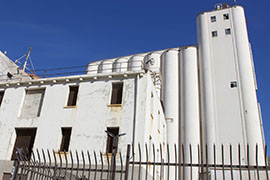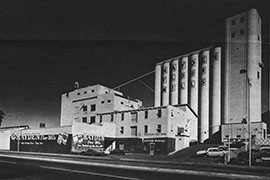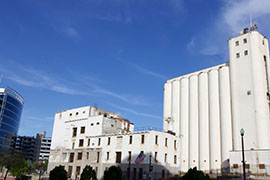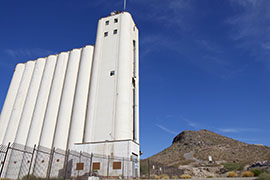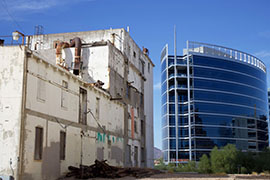- Slug: BC-CNS-Hayden Flout Mill,650 words.
- 6 photos available (thumbnails, captions below)
By Ellie Willard
Cronkite News
TEMPE – The Hayden Flour Mill silos and building have stood vacant since the mill officially closed in 1998. But that’s about to change.
In October, the city of Tempe announced the approval of a restoration and redevelopment plan for the historic Hayden Flour Mill, which stands at the corner of Mill Avenue and Rio Salado Parkway.
“The mill is truly a central, iconic building and very unique building to Tempe’s history,” said Jared Smith, senior curator at the Tempe History Museum. “It makes sense that that building is a focal point going forward.”
The current building operated from 1918 to 1998, when it closed. Since 2001, multiple renovation attempts have been proposed to no avail, mostly due to an expiration of development rights.
In 2021, Tempe issued a request for proposal for new developers and received two responses.
In early 2022, the city entered negotiations for development of the mill site and surrounding area with Venue Project, a company with experience restoring iconic buildings, and Sunbelt Holdings, which has been involved in other Tempe development projects. In October, the agreement was approved, and now the work toward revitalization can begin.
The development project calls for new restaurants and shops, a public park, restoration of the mill and its silos, and an improved trailhead to the A Mountain.
Within the next year, an environmental investigation will be done on the site to identify any harmful materials. The next step will be taking inventory of the equipment that was left behind in the building and cleaning it out or integrating it into the project as well as cleaning up the grounds of the site to begin designing the public park, according to Josh Rutherford, economic development administrator for the mill project.
Construction will likely begin in the next two to three years, and within five years, the majority of the project will be complete, Rutherford said.
Along with the development partners, the Salt River Pima-Maricopa Indian Community has been involved in negotiations about the mill, and a memorandum of understanding has established a foundation of communication between the city, the developers and SRP-MIC.
“As we move forward, every step, like the park boundaries, the development itself, they’re (SRP-MIC) very much involved as a development partner with us,” Rutherford said.
The partnership aims to ensure Indigenous people are acknowledged for their agricultural developments in Tempe through incorporating Indigenous products into retail space or having insights on the trailhead that educate and acknowledge that history, according to Rutherford.
The Hayden Flour Mill is a relic of Tempe’s agricultural past and growth of Tempe as well as being the namesake of the bustling Mill Avenue. The mill building was built in 1918 and remains the oldest cast-in-place, reinforced concrete building in Tempe.
The original Hayden Flour Mill was built in 1874 but burned down – and after being rebuilt in 1895, burned down again. Architects and builders used techniques developed in the wake of the great San Francisco earthquake and fire of 1906 to make the building fire-proof, according to the city of Tempe.
The grain elevator and silos east of the mill were constructed in 1951 and remained the tallest structures in Tempe until 2007.
After its conception, the Hayden Flour Mill company was quickly the largest purchaser of wheat in the state and one of the most prominent companies in the state’s agricultural industry.
“Highlighting this agricultural history is a core part, I think, of tying the community’s heritage and the business history back into the site where it really kind of started,” Tempe History Museum’s Smith said of the plan to honor the “legacy business” that was one of the longest-running in the state, at more than 120 years.
For more stories from Cronkite News, visit cronkitenews.azpbs.org.
^__=
The Hayden Flour Mill first opened in 1874. The current structure was built in 1918 after two previous versions were lost to fire. (Photo by Hunter Fore/Cronkite News)
Plans are underway for a revitalization of the Hayden Flour Mill in Tempe, seen here in a photo taken in 1975, when the mill was still operating. (Photo courtesy Tempe History Museum)
A 2023 photo of Hayden Flour Mill, which shut down in 1998. Despite several renovation proposals, the mill has remained closed, but officials have hopes for a new plan. (Photo by Hunter Fore/Cronkite News)
Hayden Flour Mill stands at the corner of Mill Avenue and Rio Salado Parkway, on the west side of the A Mountain. (Photo by Hunter Fore/Cronkite News)
Modern high-rise buildings surround the Hayden Flour Mill, underscoring the stark difference between the old and new construction. (Photo by Hunter Fore/Cronkite News)
Hayden Flour Mill’s grain elevator and silos east of the mill were constructed in 1951, and remained the tallest structures in Tempe for decades. (Photo by Hunter Fore/Cronkite News)
